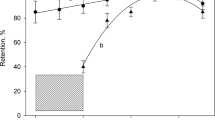Summary
The atomic-absorption behaviour of different mercury compounds in the graphite tube was investigated. It was established that in the case of water-soluble volatile mercury compounds (nitrate, chloride) there is a considerable mercury loss even during the drying of the drop. The mercury can be determined, however, in the form of colloidal mercury sulphide atca. 200° C and with atomization at a relatively low temperature. Some interferences limit the use of the method in practice (compounds evaporating together with the mercury, presence of other metals producing sulphide precipitates) but the use of mercury dithizonate overcomes these limitations. The method was applied for determination of the mercury content of waste water and waste water sludge.
Zusammenfassung
Das Verhalten verschiedener Quecksilber-Verbindungen im Graphitrohr bei der Bestimmung der Atomabsorption wurde untersucht. Bei wasserlöslichen, flüchtigen Quecksilberverbindungen (Nitrat, Chlorid) tritt schon bei dem Eintrocknen des Tropfens ein erheblicher Quecksilberverlust auf. Quecksilber kann aber in Form des kolloidalen Quecksilbersulfids bei ca. 200° C und Versprühung bei relativ niedriger Temperatur bestimmt werden. Einige Störungen begrenzen die Verwendbarkeit des Verfahrens in der Praxis (mit Quecksilber flüchtige Verbindungen, Anwesenheit anderer Metalle als Sulfide), aber die Verwendung von Quecksilber-Dithizonat beseitigt diese Störungen.
Similar content being viewed by others
References
B. Welz, Atom-Absorptions-Spektroskopie. Weinheim/Bergstraße: Verlag Chemie. 1972.
E. G. Harsányi, L. Polos, L. Bezur, and E. Pungor, Magy. Kérn. Foly.79, 471 (1973).
E. G. Harsányi, L. Pólos, L. Bezur, and E. Pungor, Hung. Sci. Instr.38, 13 (1976).
S. Dojan and W. Haerdi, Analyt. Chim. Acta76, 345 (1975).
P. E. Trujillo and E. E. Campbell, Analyt. Chemistry47, 1629 (1975).
M. P. Newton and D. G. Davis, Analyt. Lett.8, 729 (1975).
K. Nakano, T. Takada, and K. Fujita, Chem. Lett. (Chem. Soc. Japan) 1979, 869.
Z. Slovák, Analyt. Chim. Acta110, 301 (1979).
A. Halász and K. Polyák, Acta Chim. Acad. Sci. Hung.91, 26 (1976).
E. Gegus, J. Kreiter, L. Méray, and J. Inczédy, Acta. Chim. Acad. Sei. Hung.100, 211 (1979);101, 347 (1979).
O. G. Koch and G. A. Koch-Dedic, Handbuch der Spurenanalyse. Berlin-Heidelberg-New York: Springer. 1974. Bd. II. pp. 759–773.
Author information
Authors and Affiliations
Rights and permissions
About this article
Cite this article
Halász, A., Polyák, K. & Gegus, E. Processes taking place in the graphite tube: Anion and matrix effects in atomic absorption spectrometry. II. Determination of mercury. Mikrochim Acta 76, 229–238 (1981). https://doi.org/10.1007/BF01196739
Received:
Issue Date:
DOI: https://doi.org/10.1007/BF01196739




